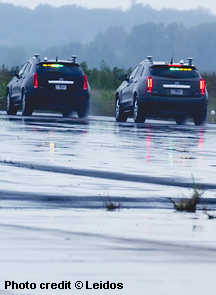U.S. Department of Transportation
Federal Highway Administration
1200 New Jersey Avenue, SE
Washington, DC 20590
202-366-4000
Federal Highway Administration Research and Technology
Coordinating, Developing, and Delivering Highway Transportation Innovations
| FACT SHEET |
| This fact sheet is an archived publication and may contain dated technical, contact, and link information |
| Publication Number: FHWA-HRT-16-044 Date: February 2016 |
Publication Number: FHWA-HRT-16-044 Date: February 2016 |
 |
The Exploratory Advanced Research ProgramCooperative Adaptive Cruise Control: Taking Cruise Control to The Next Level |
Exploratory Advanced Research…Next Generation Transportation SolutionsPDF Version (400 KB) PDF files can be viewed with the Acrobat® Reader® |
 |
Using a combination of sensors and vehicle-to-vehicle communication, cooperative adaptive cruise control (CACC) takes cruise control to the next level, enabling vehicles to adjust their speed to the preceding vehicle in their lane. The CACC system can also respond more quickly to speed changes by the preceding vehicle and other vehicles farther ahead that are beyond the line of sight. These advancements improve the stability of traffic flow, increase driver confidence, and make shorter vehicle-following distances possible. Ultimately this results in better use of a highway’s effective capacity and greater fuel efficiency. Overcoming the key remaining technical challenges to implementing CACC is the goal of the Exploratory Advanced Research (EAR) Program project “Using Cooperative ACC to Form High-Performance Vehicle Streams.” The California Partners for Advanced Transportation Technology (PATH) Program at the University of California, Berkeley (UC Berkeley), is conducting this research, which is funded by the Federal Highway Administration (FHWA). The Technical University of Delft in the Netherlands is PATH’s research partner. |
FHWA test vehicles simulate a “platoon” or stream of vehicles using cooperative adaptive cruise control, which improves traffic flow and allows drivers to use their cruise control at shorter gap settings |
The sensor-based adaptive cruise control (ACC) currently in use has significant performance limitations. These include a long delay in responding to motion changes by the preceding vehicle and a minimum time gap of 1 second in following the preceding vehicle, which is long enough to encourage other vehicles to cut into the traffic stream. This EAR project will enable CACC to overcome these limitations and provide significantly better performance for drivers. CACC enables vehicles to follow each other more closely and accurately than does conventional ACC, thus improving traffic flow and allowing drivers to safely use their cruise control at shorter gap settings. These shorter gaps can make it possible to almost double the capacity of a highway lane. CACC also helps drivers to feel more confident using cruise control, as the system activates braking action faster than a driver can react to brake lights on the preceding vehicle.
Researchers will also fill the gaps in knowledge and performance that need to be bridged before field operational tests of CACC can begin, which will be needed to enable commercialization of the technology. Knowledge gaps include defining the maneuvers that vehicles have to perform to join and leave a CACC “platoon” or stream of vehicles under different conditions and demonstrating how vehicle-to-vehicle message sets can be adjusted to support CACC operations. These sets allow vehicles to send wireless messages to other vehicles about such data as speed, location, and application of brakes.
The project researchers began their work by identifying operational concept alternatives to study in greater depth, such as multiple strategies for operating CACC platoons. The research team next developed simulation models to represent diverse real-world conditions, including urban versus rural roads, highways versus arterial roads with traffic signals, and different levels of traffic volume. Traffic simulation models also included a new program developed in the Netherlands, MOTUS (Microscopic Open Traffic), and the commercially available Aimsun model used by the PATH Program. The researchers then used the simulation models to assess the traffic flow and energy impacts of the various operational concepts under different deployment scenarios. They divided the simulation model work among the teams at UC Berkeley and the University of Delft so that each team could validate the work of the other. Metrics assessed by the models included increases achieved in traffic flow capacity per highway lane, reductions in traffic flow disturbances, reductions in vehicle energy consumption, and savings in travel times along arterial roadways.
The researchers have been analyzing the results of the simulation studies and using the data to identify the next generation of vehicle experiments that should be conducted to verify the feasibility of the most promising CACC strategies. They also have been analyzing data that PATH previously collected in tests of two generations of experimental CACC systems. This analysis is helping to expand understanding of how drivers choose to use both ACC and CACC and to clarify the safety implications of the shorter gaps in the vehicle stream enabled by CACC.
The project researchers will next test their simulation models at FHWA’s Saxton Transportation Operations Laboratory in McLean, VA.
The project researchers are making important advances in overcoming the technical challenges that currently stand in the way of implementing CACC. These project results will accelerate progress toward testing and evaluation of CACC on the road, which is the next step in moving the technology closer to real-world deployment.
For more information about the EAR project “Using Cooperative ACC to Form High-Performance Vehicle Streams,” contact Bob Ferlis in the FHWA Office of Operations Research and Development, 202-493-3268 (email: robert.ferlis@dot.gov).
 |
What Is the Exploratory Advanced Research Program?FHWA’s Exploratory Advanced Research (EAR) Program focuses on longer term, higher risk research with a high payoff potential. The program addresses underlying gaps faced by applied highway research programs, anticipates emerging issues with national implications, and reflects broad transportation industry goals and objectives. To learn more about the EAR Program, visit the EAR Web site at www.fhwa.dot.gov/advancedresearch. The site features information on research solicitations, updates on ongoing research, links to published materials, summaries of past EAR Program events, and details on upcoming events. |